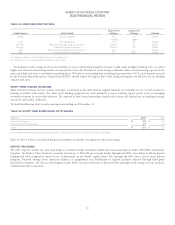American Express 2014 Annual Report Download - page 40
Download and view the complete annual report
Please find page 40 of the 2014 American Express annual report below. You can navigate through the pages in the report by either clicking on the pages listed below, or by using the keyword search tool below to find specific information within the annual report.
AMERICAN EXPRESS COMPANY
2014 FINANCIAL REVIEW
TABLE 18: REGULATORY RISK-BASED CAPITAL AND LEVERAGE RATIOS
Basel III
Standards
2014(a)
Ratios as of
December 31,
2014
Risk-Based Capital
Common Equity Tier 1 4.0%
American Express Company 13.1%
American Express Centurion Bank 18.8
American Express Bank, FSB 14.2
Tier 1 5.5
American Express Company 13.6
American Express Centurion Bank 18.8
American Express Bank, FSB 14.2
Total 8.0
American Express Company 15.6
American Express Centurion Bank 20.1
American Express Bank, FSB 16.0
Tier 1 Leverage 4.0%
American Express Company 11.8
American Express Centurion Bank 18.7
American Express Bank, FSB 15.1
Common Equity to Risk-Weighted Assets
American Express Company 15.0
Tangible Common Equity to Risk-Weighted Assets(b)
American Express Company 12.0%
(a) Transitional Basel III minimum and conservation buffer as defined by the Federal Reserve for calendar year 2014 for Advanced Approaches institutions.
(b) Refer to page 41 for a discussion of tangible common equity, a non-GAAP measure.
The transition provisions for 2014 under Basel III cause our reported capital ratios to be higher than they would have been under the prior
regulatory standards, known as Basel I. Specifically, the Common Equity Tier 1 risk-based capital and Tier 1 risk-based capital ratios would
have been approximately 45 and 40 basis points lower, respectively, under Basel I. The largest contributor to the difference is the way
intangible assets are being treated and ultimately transitioned in over a 5-year period under Basel III.
We seek to maintain capital levels and ratios in excess of the minimum regulatory requirements and finance such capital in a cost efficient
manner; failure to maintain minimum capital levels could affect our status as a financial holding company and cause the respective
regulatory agencies to take actions that could limit our business operations.
Our primary source of equity capital has been the generation of net income. Historically, capital generated through net income and other
sources, such as the exercise of stock options by employees, has exceeded the annual growth in our capital requirements. To the extent capital
has exceeded business, regulatory and rating agency requirements, we have historically returned excess capital to shareholders through our
regular common share dividend and share repurchase program.
We maintain certain flexibility to shift capital across our businesses as appropriate. For example, we may infuse additional capital into
subsidiaries to maintain capital at targeted levels in consideration of debt ratings and regulatory requirements. These infused amounts can
affect the capital profile and liquidity levels at the American Express parent company level. We do not currently intend or foresee a need to
shift capital from non-U.S. subsidiaries with permanently reinvested earnings to a U.S. parent company.
The following provides definitions for our regulatory risk-based capital ratios and leverage ratio, which are calculated as per standard
regulatory guidance:
Risk-Weighted Assets — Assets are weighted for risk according to a formula used by the Federal Reserve to conform to capital adequacy
guidelines. On- and off-balance sheet items are weighted for risk, with off-balance sheet items converted to balance sheet equivalents, using
risk conversion factors, before being allocated a risk-adjusted weight. The off-balance sheet items comprise a minimal part of the overall
calculation. Risk-weighted assets under Basel I as of December 31, 2014 were $133.3 billion.
40
























